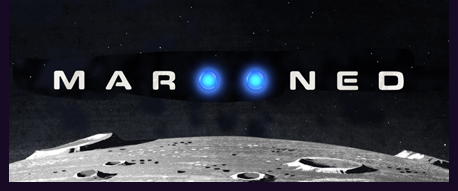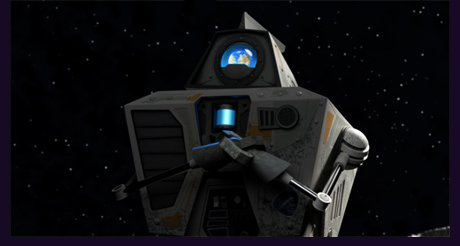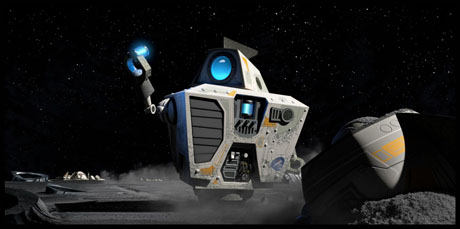
Story artist Andrew Erekson (Home, Captain Underpants) is premiering his directorial debut at the Annecy International Film Festival in France this week. The DreamWorks Animation short Marooned is about two robots stuck on the Moon hoping to return to Earth. And he’s certainly over the moon about showing his creation to audiences.
Andrew Erekson: I’m excited. It’s new for me. I’m getting used to a lot of new things, but yeah I’m excited. A little nervous.
Jackson Murphy: I’ve always been interested in space travel and astronauts. This is the 50th anniversary of the Moon landing. Have you always been interested in space, space travel and robots?
AE: Oh yeah. For sure. Growing up, I think I went to bed almost every night watching an episode of Star Trek: The Next Generation, which was probably a big influence on me. I’ve always been fascinated with space and space exploration and robots. I always found robots to be interesting because they could be… humanoid or they could just look like the robots in my shorts – ovens.

JM: C-0R13 definitely looks like an oven. How did you determine that that’s what you wanted for the look?
AE: When I was coming up with the design for him, I’ve always had this philosophy of working general to specific. It’s something I learned in school doing illustrations. Basically, I at first came-up with shapes: it was a square and an oval. Based on the shapes dictated what the personalities [of the characters] were – the square being a bit more stoic and sturdy and a bit of a curmudgeon. And then the circle perhaps softer, rounder, naive, more childlike. That’s what they started-out design-wise. And then as I was going, I was looking at all sorts of references from 50s and 60s design, like old radios and televisions. Ultimately it was a culmination of all those things.
And then there are a couple little easter eggs on there for the robots themselves. I’ve always been a fan of “The Rocketeer”. I love the little fin in the shape of his helmet. C-0R13’s name is Corie. It’s sort of disguised in there. And the other little robot’s name is Alicia. So her name is disguised as A-L1C1A. I took the fin off of paying an homage to “The Rocketeer”. His fin on his head is a nod to that, and her little mohawk is a little nod to “The Iron Giant”, which is another favorite robot movie of mine.

Andrew Erekson
AE: I didn’t. When I came up with the title, like you, I actually Googled the name “Marooned” to see if any movies at all had been named that. The only thing I did was watch it – because it was showcased on an episode of Mystery Science Theater 3000. I’m a fan of that show too.
JM: One of the highlights of your short is the score. It’s very comforting and classic, which I like a lot. What were your overall goals with the music?
AE: I’ve always been a fan of movies that have themes or motifs. Growing up with a lot of Spielberg, John Williams, Alan Silvestri, James Horner – all of these movies I grew up with… that corn-gold approach to scoring, was something that always stuck with me. I like those motifs representing the characters. They stick with you more. And that’s something I feel is lost, somewhat, nowadays. A lot of film scores don’t go that way anymore – not that they’re bad, they’re just different. I wanted to harken back to those thematic elements in the score.
When talking with the composer, Amie Doherty, she really caught onto this too. I really wanted to have an Earth rise theme. Every time you saw the Earth, we would have this theme running through. And then we had a working theme – and different variations to suggest their mood. And then I also wanted whistling. Whistling is fun. Ennio Morcione’s scores you hear whistling. I always find that stuff fun to do and it helps with the characters.
One thing Amy Doherty suggested, which I thought was brilliant, was to represent each character with an instrument. Corie is represented by a bass clarinet. And Alicia is represented by a mandolin. As they come into play in each shot, you’ll hear those instruments representing the characters. It’s a subtle thing, but I thought it was a great little touch to help give vocalization to the characters.
JM: So I’m not going to give away the ending, but every frame of this short is very important. Was the structure of the final minute or so of Marooned always planned like that?
AE: I had a couple different endings. As I was showing it to different people, I would get different suggestions. The button or little tag after the end credits… was something I had in my back pocket. I always felt the short worked either way – you could have it with or without. I felt, to be honest, it was a little stronger if you took it off. But then once we put it on, and I saw the reaction of audiences, and the way it was executed, I was fine with it. It’s interesting as people watch it to hear the audible reaction to it.

JM: That’s fascinating. By the way, when you go to Annecy, I think they’re going to love that the Eiffel Tower gets a real showcase in the short.
AE: Yeah. That was something we didn’t plan, so it will be kind of interesting to see the reaction.
JM: You have a lot of other things going on. I know extended footage of upcoming DreamWorks feature “Abominable” will be shown at Annecy as well. You’re a storyboard artist on the film. How was it working on that?
AE: “Abominable” was really great to work on. I worked on it with [directors] Jill Culton and Todd Wilderman, who I’ve known from when I used to work at Sony. Jill was actually the first person who hired me to work on “Hotel Transylvania”. She gave me my first job storyboarding, and that’s where I met Todd and we became good friends. In a weird way we all ended-up at DreamWorks. “Abominable” went through a lot of different changes, as these things do. It was fun and interesting to see how it evolved and changed from one story to another. I haven’t seen the final picture, but what I’ve seen looks amazing.
JM: Is “Marooned” going to be shown in front of “Abominable” in theaters?
AE: I don’t know. That’s something that’s been talked about, but I don’t think it’s really been decided. So we’ll see. I would love it.
JM: Fingers crossed! You also worked on the third “Dragon” movie. I think 2019 for DreamWorks, based on these two movies and your short, can be defined by characters longing for their true homes. How does that theme really speak to you?
AE: It’s kind of coincidence that all three of these come out simultaneously. But as a theme, it’s something relatable. A lot of people, in some way or another, can relate to that. I think that’s always good to have in any storytelling – a theme or notion that people can grasp onto that has universal appealing. Especially in the case of “Marooned” which, in all intensive purposes, is a silent film – those things have to be really strong and ring loud even though we’re silent.
JM: I know you’re also working on “The Boss Baby 2” – you’re head of story. Have you been working with Alec Baldwin yet on this?
AE: Me personally – no. I know there have been some recordings. The director and producers have been working with him.

JM: “The Boss Baby” was such a big hit – and an Oscar nominee. I think a lot of people are anxiously awaiting the return of this character.
AE: Yeah, I think so. I know Baldwin was excited when we told him about the story and the prospect of returning to that role. I know he does call sometimes and gives his own notes and ideas. So it’s neat to have somebody that’s invested in it and wants it to be successful. He’s the voice actor, of course, but he’s still interested enough to give ideas, thoughts and notes.
JM: That’s great to hear. You’ve also been nominated for two Daytime Emmy awards for your work on the DWA series “Trollhunters”. You’ve gone back and forth between movies and TV. Has that been challenging?
AE: Yeah, but in good ways. Working in features, you have the benefit of working things over and over and trying things out, testing things out, letting them fail, and trying them again. It can be a little monotonous. So there’s pros and cons to each. And when you go to television, you basically get a very little amount of time. And you gotta get it done. And what you get done is up on the screen in a very short amount of time. So there’s something satisfying of being able to go, “Oh – I did that and there it is.”
With working in television, you get a lot of mileage in. As an artist, you get better a lot quicker because of the time restraints and other restrictions they have in TV. And it’s kind of cool to come back to features with that experience and apply it to features, whether it’s speed or being a better draftsman – better at telling stories. It’s nice to see both sides of it.
JM: And you’re making shorts, too. Are there more shorts in your future?
AE: I’ll be continuing on “Boss Baby 2”. I do have ideas for maybe a feature that I’ll hopefully be able to put together and pitch at some point. And we’ll see what happens.
- INTERVIEW: Jeff Fowler On “Knuckles” And “Sonic 3” - April 22, 2024
- INTERVIEW: “Inside Out 2” Director And Producer On Pixar Sequel - April 16, 2024
- INTERVIEW: “Puffin Rock And The New Friends” And 25 Years Of Cartoon Saloon - April 10, 2024


 June 11th, 2019
June 11th, 2019  Jackson Murphy
Jackson Murphy  Posted in
Posted in  Tags:
Tags: 






